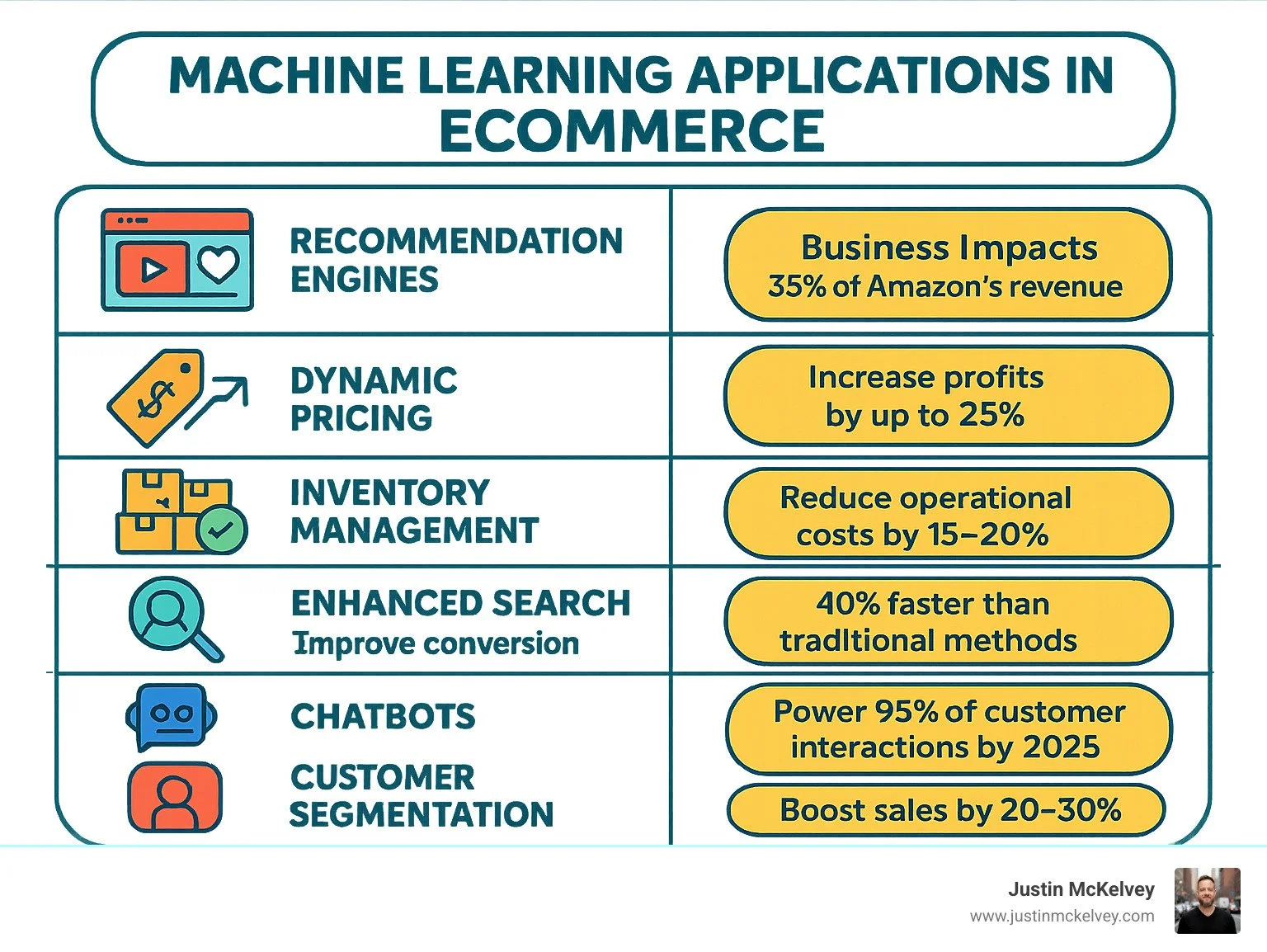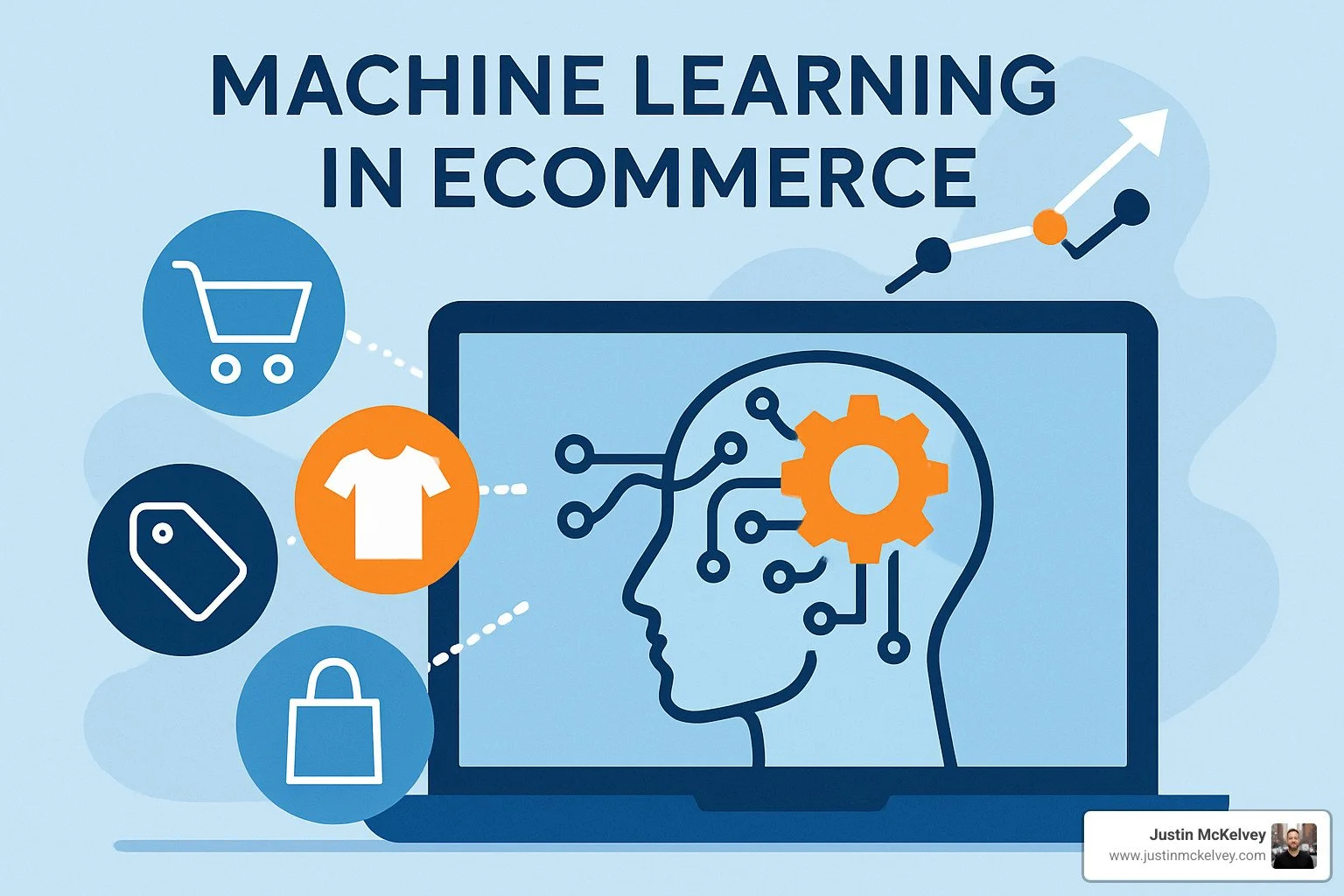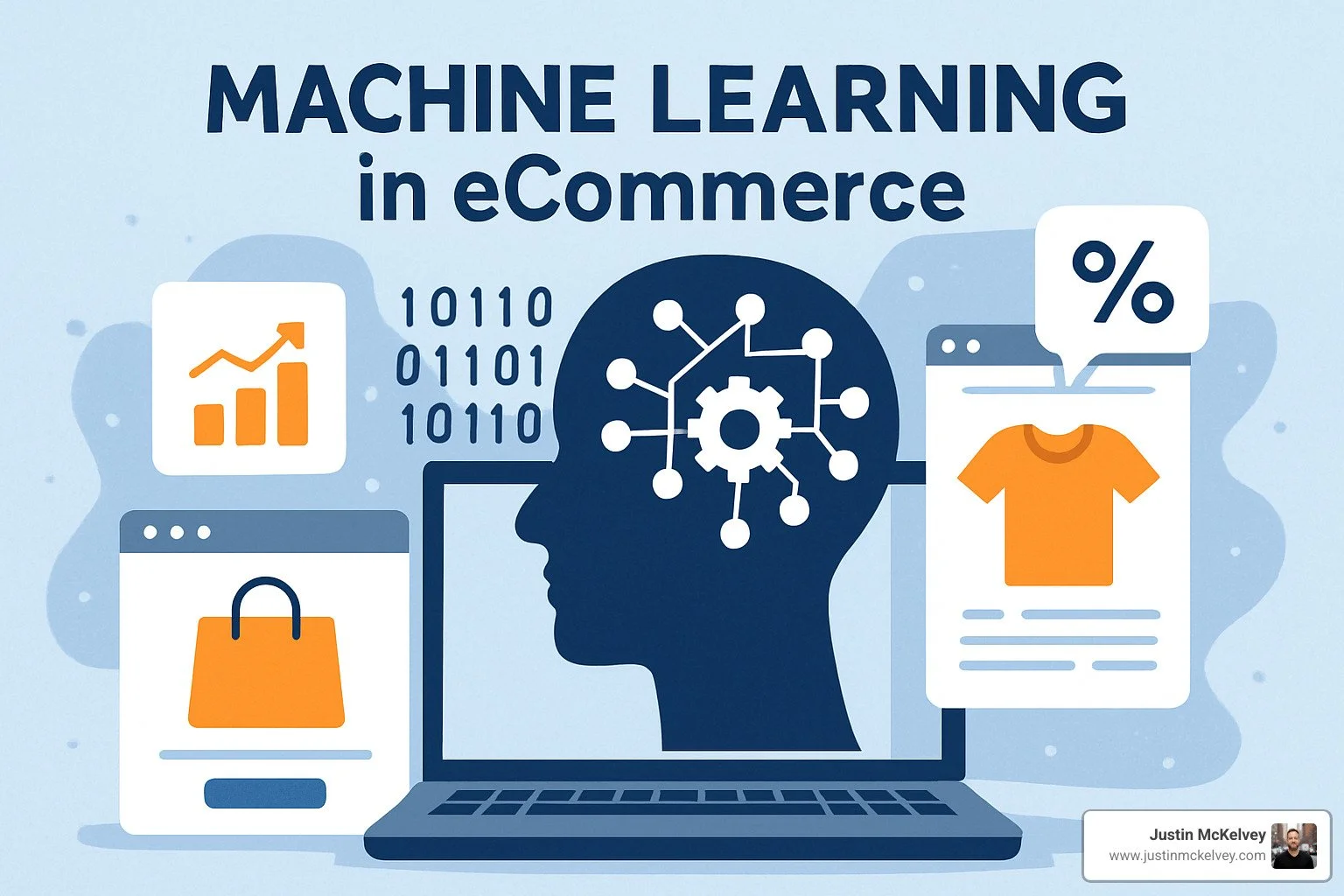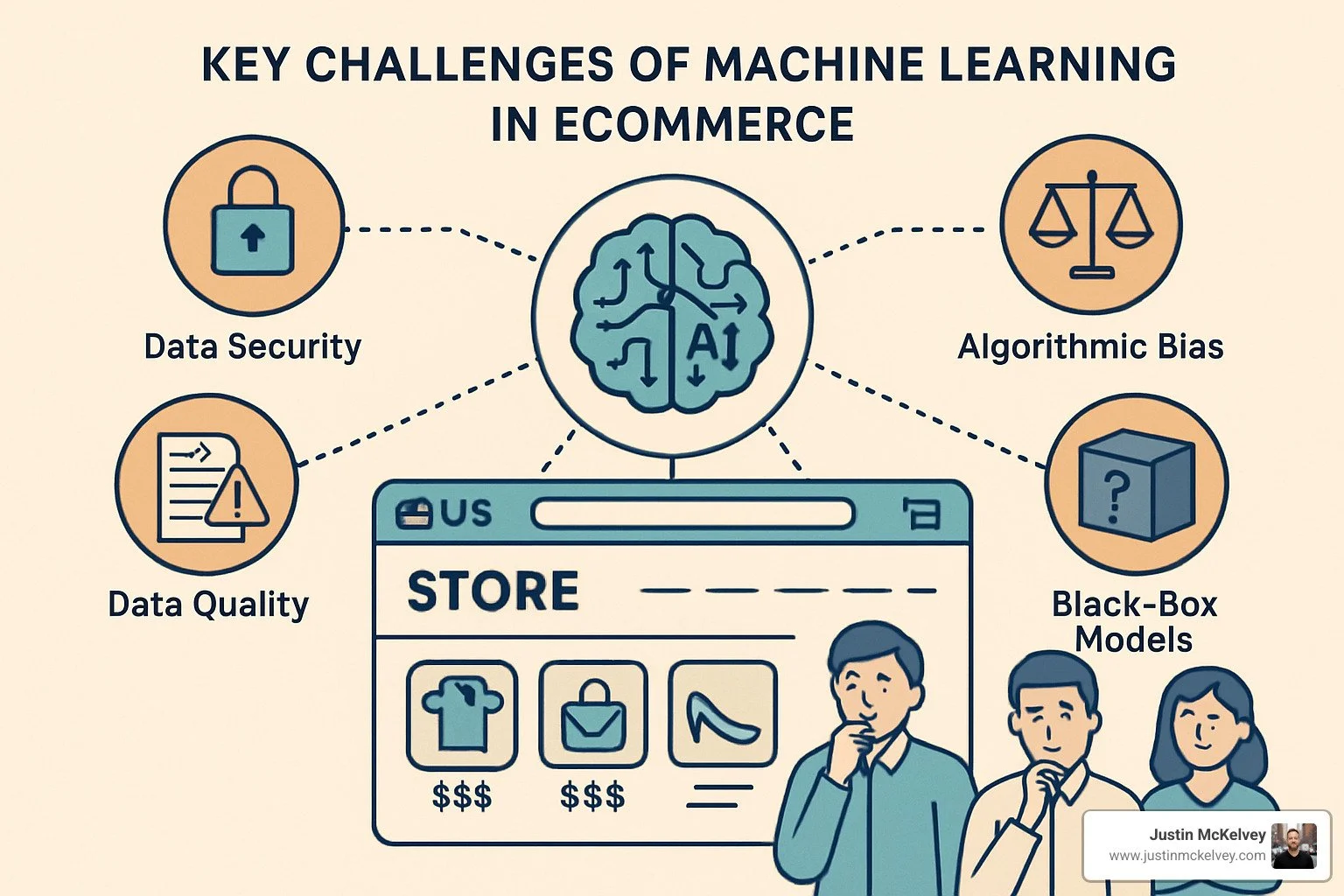How Machine Learning is Transforming eCommerce: Real-World Applications
The Evolution of eCommerce Through Machine Learning
Machine learning in eCommerce is revolutionizing how online retailers operate and how customers shop. For business leaders looking to understand this technology's impact, here are the key applications at a glance:
Behind the seemingly effortless online shopping experience lies a complex network of sophisticated algorithms. What feels like a series of simple clicks to consumers is actually powered by advanced machine learning systems working tirelessly to personalize, optimize, and secure the shopping journey.
Global e-commerce has grown into a $4.88 trillion industry with an expected annual growth rate of 20%. This explosive expansion has made machine learning not just advantageous but essential for staying competitive. As Amazon CEO Andy Jassy once noted, "Machine learning is the electricity of the 21st century," and nowhere is this more evident than in online retail.
For business leaders, implementing machine learning isn't just about keeping up with technology trends—it's about tangible business outcomes. Companies using AI-powered solutions in eCommerce can expect customer satisfaction, cost reduction, or revenue to grow by at least 25% by 2023, according to industry projections.
Whether you're running a small Shopify store or managing an enterprise-level retail platform, machine learning applications can transform how you understand customers, manage inventory, price products, and detect fraud—all while improving the shopping experience.
What Is Machine Learning in eCommerce & Why It Matters
Machine learning in eCommerce is like having a digital sales assistant that gets smarter with every customer interaction. Unlike traditional software that follows rigid instructions, ML systems learn and adapt from data, continuously improving how they serve both shoppers and retailers.
Think of it this way: while conventional programs can only follow the script you give them, machine learning systems write their own script based on what they observe. For online stores, this means technology that can:
Learn your customers' unique preferences from their browsing habits and purchase history Anticipate which products they're likely to want next Spot unusual patterns that might signal fraudulent activity Predict inventory needs before you run out of popular items Adjust pricing strategies based on real-time market conditions
According to research from McKinsey, personalization powered by machine learning can boost revenue by 10-15% and improve customer retention by a remarkable 25%. These aren't small gains—they're game-changing improvements that can transform market challengers into market leaders.
The beauty of machine learning in eCommerce is that it creates a win-win situation. Shoppers enjoy more relevant experiences custom to their needs, while retailers benefit from increased sales and operational efficiencies. It's like having a store that rearranges itself for each customer who walks through the door.
Key Differences from General AI
While general AI aims to mimic human intelligence across many domains, machine learning in eCommerce is more focused on practical, immediate business results:
Supervised learning forms the backbone of most eCommerce applications. These systems train on labeled data—like "customers who bought this also bought that"—to make smart predictions about future behavior.
Deep learning takes this a step further by using complex neural networks to analyze multiple factors simultaneously. This is what powers those eerily accurate product recommendations and visual search features that recognize products from images.
Traditional rule-based systems might suggest winter coats to everyone in December, but ML systems know better. They'll consider your location (maybe you're in Miami), your browsing history, and even the current weather before making recommendations that actually make sense for you.
While some ML models can be mysterious "black boxes," the best eCommerce applications prioritize explainability—making sure businesses and customers understand why certain recommendations or decisions are made. This builds trust and provides valuable business insights.
Core Business Benefits
Implementing machine learning in eCommerce delivers concrete benefits that impact your bottom line:
Higher Average Order Value is perhaps the most immediate benefit. When customers receive personalized recommendations that complement what they're already buying, basket sizes typically increase by 10-15%.
Lower Customer Acquisition Costs result from smarter targeting. Rather than casting a wide net, ML-powered marketing zeroes in on the prospects most likely to convert, making your advertising dollars work harder.
Operational Savings of 15-20% are common when ML handles inventory forecasting and management. The system learns from seasonal patterns, identifies trends, and prevents both stockouts and overstock situations.
Faster Decision-Making becomes possible when data is processed in real time. Pricing adjustments, inventory shifts, and marketing pivots can happen immediately in response to market conditions rather than weeks after an opportunity has passed.
The real power of machine learning in eCommerce comes from its ability to process and learn from vast amounts of data that would overwhelm human analysts. By finding patterns and connections invisible to the naked eye, these systems help online retailers create experiences that feel remarkably human—personal, intuitive, and responsive to each shopper's unique needs.
Real-World Applications List: Where Machine Learning in eCommerce Shines
Let's explore the exciting ways machine learning in eCommerce is changing online shopping. These aren't just theoretical concepts—they're practical applications that are changing how businesses operate and how customers shop right now.
Personalized Recommendations with machine learning in eCommerce
Have you ever wondered how Amazon seems to know exactly what you want to buy next? That's the magic of recommendation engines at work.
These clever systems analyze your clicks, purchases, and browsing habits to suggest products you're likely to love. They work in different ways—some use collaborative filtering (essentially "people like you bought this"), while others use content-based filtering (finding products similar to ones you've shown interest in). Many modern systems combine both approaches for better results.
The impact is stunning: Amazon reports that 35% of its revenue comes directly from these recommendations. And it's not just retail—Netflix says 75% of what users watch comes from their recommendation system.
I recently spoke with a jewelry retailer who implemented a smart recommendation engine that looks at browsing patterns and time spent viewing items. They saw their average order value jump by 23%, and customers kept coming back for more. That's the power of showing people exactly what they want, sometimes before they even know they want it!
Dynamic Pricing powered by machine learning in eCommerce
Remember when all products had fixed price tags? Those days are rapidly disappearing in the online world. Machine learning in eCommerce now enables prices to shift in real-time based on demand, competition, inventory levels, and even the weather!
Smart pricing algorithms constantly monitor market conditions and make thousands of tiny adjustments throughout the day. They know when to hold firm on price and when a small discount might trigger a purchase.
This matters because price remains the deciding factor for nearly half of all online shoppers (47% according to recent studies). Retailers using dynamic pricing typically see profit increases up to 25%—a game-changing advantage in competitive markets.
An electronics retailer I worked with implemented dynamic pricing during the holiday season last year. Their system made over 5,000 price adjustments daily, helping them stay competitive while protecting their margins during their busiest season.
Inventory Forecasting & Smart Supply Chains
Nothing kills sales faster than the dreaded "out of stock" message—except maybe having too much inventory eating up your capital and warehouse space. Machine learning in eCommerce solves both problems.
Modern ML systems analyze years of sales data, looking for patterns humans might miss. They factor in seasonality, upcoming holidays, weather forecasts, and even social media trends to predict exactly what you'll need and when.
The business impact is substantial—operational costs typically drop by 15-20%, while stockouts can be cut in half. For retailers with thousands of products, this can mean millions in saved costs and prevented lost sales.
A global fashion retailer I know uses ML to forecast demand across their entire product line. Their system even picks up on Instagram trends to predict sudden demand spikes. The result? They reduced inventory costs by 18% while actually improving product availability. That's the definition of winning on both fronts!
Intelligent Search & Visual Find
Have you ever tried searching for something you couldn't quite describe? Traditional search is helpless here, but machine learning in eCommerce is changing the game with intelligent search options.
Today's ML-powered search understands typos, slang, and even the intent behind your search. It knows that when you type "black dress shoes men formal," you're looking for men's formal black dress shoes, even if that's not exactly what you typed.
Even more impressive is visual search, where you can simply snap a photo of something you like and find similar items. Beauty.com saw sales jump 15% after adding this feature, while eBay improved search relevance by 10-15% with their ML systems.
I love the story of a home furnishing retailer who added visual search to their mobile app. Customers could take pictures of furniture they spotted in a café or friend's home and instantly find similar items in the store's catalog. This simple feature cut the search-to-purchase time by 30% and boosted mobile conversions by 25%.
Fraud Detection & Risk Mitigation
Online fraud is an unfortunate reality in eCommerce, costing businesses billions annually. Thankfully, machine learning in eCommerce is our best defense.
ML fraud detection systems work like digital security guards that never sleep. They analyze hundreds of signals in milliseconds—looking at transaction patterns, device information, typing speed, and countless other factors to spot potential fraud. The best part? They get smarter over time, learning from each new fraud attempt.
These systems work 40% faster than traditional methods and generate far fewer false positives—meaning fewer legitimate customers get wrongly flagged. According to PwC, with 51% of organizations encountering fraud in the past two years, this protection is essential.
One multi-brand retailer I consulted with implemented an ML fraud system that cut chargebacks by 60% while halving the number of transactions needing manual review. Their system caught subtle fraud patterns that traditional rule-based systems completely missed.
Chatbots & Virtual Assistants for CX
"How can I help you today?" That friendly question increasingly comes from an AI assistant rather than a human agent. Machine learning in eCommerce has made chatbots remarkably good at understanding customer questions and providing helpful responses.
Today's ML-powered chatbots understand natural language, recognize customer intent, maintain conversation context, and know when to smoothly hand off to a human agent for complex issues.
The impact on customer service is profound—industry projections suggest AI will handle 95% of customer interactions by 2025. The best chatbots already handle 80% of routine questions, freeing human agents for more complex customer needs.
An electronics retailer I worked with deployed an ML chatbot that handles everything from product recommendations to technical support. Customer questions that once took hours to answer now receive responses in seconds, and the bot has boosted conversion rates by 12% by providing timely assistance during the purchase process.
Marketing Segmentation & Customer Lifetime Value Prediction
Not all customers are created equal—some will become loyal brand advocates while others make a single purchase and disappear. Machine learning in eCommerce helps identify which is which.
Advanced clustering algorithms group customers based on subtle behavioral patterns, allowing for hyper-targeted marketing. Predictive models can spot early warning signs of customer churn, enabling proactive retention efforts. And look-alike modeling helps find potential customers who resemble your very best existing ones.
The business impact is significant—omnichannel personalization strategies typically deliver 10-15% revenue uplift and substantially improved retention rates. Knowing a customer's likely lifetime value helps businesses invest marketing dollars where they'll generate the highest return.
I worked with a subscription box service that uses ML to predict customer lifetime value within just 60 days of signup. This insight allows them to adjust their acquisition spending and retention efforts based on predicted value, resulting in a 30% improvement in marketing ROI.
For businesses looking to implement these solutions, Cloud-Based Business Solutions offer accessible entry points without massive infrastructure investments. The beauty of modern ML is that you don't need to build everything from scratch—there are powerful tools ready to deploy for businesses of all sizes.
Implementation Roadmap & Best Practices
Turning machine learning in eCommerce from a buzzword into business reality doesn't happen overnight. I've seen companies rush headlong into ML projects without proper planning, only to end up with expensive systems that don't deliver value. Let's avoid that fate with a thoughtful approach.
Step-by-Step Getting Started
Think of implementing ML like building a house - you need a solid foundation before adding fancy features. Start by aligning with business goals that matter. Rather than saying "we need AI," identify specific problems like "we need to reduce our return rate" or "we want to increase repeat purchases."
Next, conduct a thorough data audit. The quality of your ML is only as good as the data feeding it. Many eCommerce businesses are sitting on goldmines of customer data but haven't organized it properly. Clean, consistent data is the fuel for your ML engine.
When it comes to choosing tools, you have options. For most businesses, starting with ready-made SaaS solutions makes the most sense - they're like buying a car instead of building one from scratch. Custom solutions make sense when you have truly unique needs or competitive advantages to protect.
I always recommend starting with a focused MVP (Minimum Viable Product) approach. Pick one high-impact area - perhaps product recommendations or inventory forecasting - and prove the concept works for your business. Success breeds confidence for further investment.
Once you've shown results, iterate and scale. Use what you've learned to refine your approach and expand to other areas of your business. This gradual expansion helps manage risk and builds internal expertise.
In our work at Justin McKelvey, we've found that a hybrid approach often delivers the best results. Start with SaaS solutions for common applications like recommendation engines while building custom solutions only where you have unique competitive advantages. This balanced approach delivers quick wins while building toward long-term differentiation.
Compliance & Privacy Guardrails
Let's be real - nothing kills customer trust faster than mishandling their data. When implementing machine learning in eCommerce, privacy can't be an afterthought.
GDPR compliance isn't just about avoiding fines (though those can be substantial). It's about respecting customer boundaries and being transparent about how you use their information. Make sure you have proper consent mechanisms in place, especially for personalization features.
If you're handling payments, PCI DSS compliance is non-negotiable, even when using ML for fraud detection. ML models themselves can potentially memorize sensitive information, so be cautious about what data you feed them.
Whenever possible, use data anonymization techniques. Your recommendation engine doesn't need to know customers' names or addresses to suggest relevant products - it needs patterns, not personal identifiers.
Above all, maintain transparent data practices. Your privacy policy shouldn't require a law degree to understand. Tell customers in plain language how you're using their data to improve their shopping experience.
Building Cross-Functional Talent & Governance
The most sophisticated ML system will fail without the right people and processes supporting it. Consider establishing an ML center of excellence that brings technical and business minds together. This creates a shared understanding of both the possibilities and limitations of ML technology.
Don't underestimate the importance of training programs for your existing staff. You don't need to turn everyone into data scientists, but basic ML literacy across departments helps ensure the technology is applied appropriately.
Finally, thoughtful change management is crucial. Be sensitive to workforce concerns about automation. I've found that the most successful implementations position ML as a tool that augments human capabilities rather than replaces them. Clear communication about how ML will make jobs more interesting and impactful (rather than obsolete) helps build internal champions rather than resistance.
For businesses looking to implement Cloud-Based Business Solutions or seeking SaaS Technology Consulting, these principles apply equally - start small, focus on business outcomes, and build capabilities incrementally.
Challenges, Risks & How to Overcome Them
Let's face it—implementing machine learning in eCommerce isn't all smooth sailing. Even with its impressive benefits, there are real challenges that business owners and technology leaders encounter along the way.
Think of ML as a powerful vehicle—it can take your business to amazing places, but you need to know how to handle the curves in the road.
The black-box problem is one of the trickiest challenges. Many sophisticated ML models (especially deep learning systems) work like a talented but uncommunicative chef—they serve up delicious recommendations, but when you ask "how did you make this?" you get a shrug instead of a recipe. This lack of transparency can make it difficult to understand why your system recommended those particular shoes to that specific customer.
Algorithmic bias is another thorny issue. Your ML systems are learning from your data—including any hidden biases that might be lurking there. If your historical data shows you've primarily served certain demographic groups, your recommendations might unintentionally favor those groups, potentially alienating others.
Then there's the data quality challenge. As the saying goes: garbage in, garbage out. If your product catalog has inconsistent tagging, missing attributes, or outdated information, your ML systems will struggle to deliver accurate results. It's like trying to bake a cake with some mislabeled ingredients—the results can be unpredictable!
The ROI uncertainty keeps many business leaders awake at night. When multiple marketing initiatives and website improvements are happening simultaneously, it can be challenging to isolate exactly how much revenue your ML recommendation engine is generating versus other factors.
And let's not forget about workforce concerns. Your team might worry that these smart algorithms are coming for their jobs. The marketing specialist who's spent years developing intuition about customer segments might feel threatened by an algorithm that claims to do segmentation better and faster.
Mitigation Tactics
The good news? Every challenge has a solution. Here's how to smooth out those bumps in the road:
Accept explainable AI approaches when possible. Some ML models are naturally more transparent than others. For customer-facing applications like product recommendations, consider using models that can provide a simple explanation like "recommended because you viewed similar items" rather than completely opaque algorithms.
Implement robust monitoring dashboards that keep an eye on your ML systems. These dashboards should track not just performance metrics but also watch for potential bias or model drift. Think of these as the check engine light for your ML systems—they'll help you spot problems before they affect your business.
Start with incremental rollouts rather than organization-wide implementations. Choose a specific product category or customer segment for your first ML project. This approach limits risk while giving your team valuable experience. We've seen clients have great success starting with a single recommendation module on product detail pages before expanding to site-wide personalization.
Establish ethical review processes for your ML applications. This doesn't need to be complicated—even a simple checklist that examines potential bias, privacy implications, and customer transparency can help prevent problems before they start.
Above all, communicate clearly with both customers and employees. Explain to customers how personalization improves their shopping experience while respecting their privacy. Help your team understand that ML tools are designed to improve their capabilities, not replace them.
At Justin McKelvey, we've guided numerous eCommerce businesses through these challenges by building structured governance frameworks and starting with high-impact, low-risk ML applications. This approach builds organizational confidence and creates a foundation for more ambitious projects. The key is finding the right balance between innovation and pragmatism—pushing the boundaries of what's possible while keeping both feet firmly planted in business reality.
For more information on navigating these challenges, check out our guide on Business and Technology Solutions that can help you implement ML in a way that's right for your unique business.
Frequently Asked Questions about Machine Learning in eCommerce
How does ML differ from general AI in online retail?
When we talk about machine learning in eCommerce, we're focusing on a specialized branch of AI that's laser-focused on improving specific aspects of online shopping.
Think of general AI as a jack-of-all-trades trying to mimic human intelligence across the board. ML, on the other hand, is more like your detail-oriented team member who becomes an expert at specific tasks by learning from patterns in your data.
In the online retail world, this means ML tackles concrete challenges like figuring out which products to recommend, when to adjust prices, or spotting that suspicious transaction that doesn't quite look right. The beauty of these systems is that they get smarter over time as they analyze more of your customer data, without needing someone to reprogram them for every new scenario.
Can small eCommerce stores leverage ML without data scientists?
Good news for small business owners – you absolutely can harness the power of machine learning in eCommerce without hiring a team of data scientists!
The eCommerce platforms you're likely already using, like Shopify, Magento, or WooCommerce, come with built-in ML features or offer plugins that add these capabilities. These tools can help you automatically recommend products to customers or improve your site search with minimal setup.
For more specialized needs, there are plenty of subscription-based services that focus on specific functions like personalizing the shopping experience or protecting you from fraud. These typically offer user-friendly interfaces designed for business owners, not tech experts.
If you're feeling a bit more adventurous, companies like Google, Amazon, and Microsoft provide ML tools through their cloud platforms that can be integrated into your store without requiring deep technical expertise.
The key is starting with a single, specific business problem you want to solve. Maybe it's reducing abandoned carts or improving product findy. Begin there with a ready-made solution, and as your business grows, you can gradually explore more sophisticated ML strategies.
What data regulations must ML initiatives follow?
Implementing machine learning in eCommerce means handling sensitive customer data, so staying on top of regulations is essential for both legal compliance and maintaining customer trust.
GDPR in the European Union sets the gold standard for data protection. If you serve European customers (which most online stores do), you'll need clear consent before collecting and processing data, provide a way for customers to request their data be deleted, and be transparent about how automated systems make decisions that affect them.
Closer to home for many US businesses, the CCPA/CPRA in California gives consumers significant rights regarding their personal information. This includes knowing what data you're collecting and how you're using it.
If you're processing payments (and what eCommerce store isn't?), PCI DSS compliance is non-negotiable. These standards protect payment card data, which is particularly important when your ML systems are analyzing transaction patterns.
Depending on what you sell, you might face additional regulations. For instance, if your products relate to health, HIPAA compliance could come into play.
To stay on the right side of these regulations, build privacy considerations into your ML systems from day one, keep detailed records of what data you're collecting and why, and regularly review your practices as regulations evolve. This approach not only keeps you compliant but also builds customer confidence in how you handle their information.
Conclusion
Machine learning in eCommerce has transformed from a nice-to-have competitive edge to an absolute must-have for online retailers. Throughout this article, we've seen how ML touches every part of the eCommerce journey—creating personalized shopping experiences, setting smart prices, making operations smoother, and keeping transactions secure.
The numbers tell a compelling story: the global AI retail market is on track to grow from $8.41 billion in 2022 to a staggering $45.74 billion by 2032. That's an 18.45% compound annual growth rate! This remarkable expansion reflects how deeply ML is reshaping online retail.
If you're just starting your ML trip, here's your straightforward path forward:
Begin with clear business challenges where machine learning can deliver real, measurable results. Maybe that's reducing cart abandonment or improving inventory accuracy—pick something concrete that matters to your bottom line.
Mix and match off-the-shelf solutions with custom options based on your unique situation. Not everything needs to be built from scratch! Sometimes the pre-built tools work perfectly well.
Make clean, accessible data your foundation. Without good data, even the smartest algorithms fall flat.
Build strong ethical guidelines and governance from day one. This protects both your customers and your business reputation.
Start small and scale up as your team builds confidence and expertise. Success breeds success!
At Justin McKelvey, we help eCommerce businesses steer this journey without the headaches. We cut through technical complexity to focus on what really matters—improving your business results. Our approach always starts with understanding your specific business needs before recommending technology solutions, ensuring your ML investments actually pay off.
The future belongs to online retailers who can effectively use machine learning in eCommerce to create shopping experiences that are more personal, efficient, and secure. By taking thoughtful steps now, you'll position your business to thrive in this rapidly changing landscape.
Want to learn how we can help you put machine learning to work in your eCommerce business? Check out our Achievr growth platform, specifically designed to help businesses like yours implement technology solutions that drive real, measurable results.









